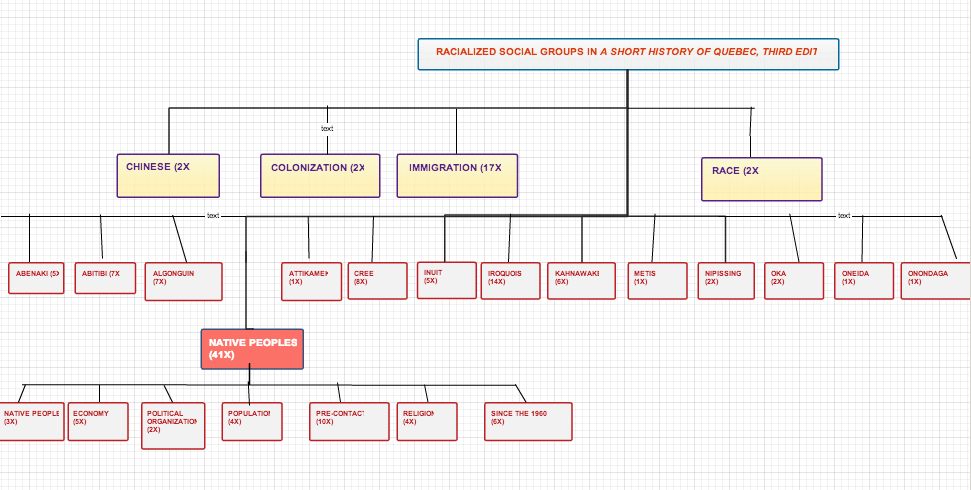Bootcamp: Trees
I am a firm believer that the history of Québec is a collection of paradoxes and contradictions dressed in settler-colonialist and nationalist-driven social and political development. As a scholar deeply concerned with engaging in revisionist histories of Québec, I decided this week to take on a text that has plagued me for the past few years: A Short History of Quebec, Third Edition by John Dickinson and Brian Young. This text is often regarded as a cornerstone text in most studies and university courses on the province. I, however, take serious issue with the text.
Let’s face it, history is often written by those in power: white, heterosexual men. I have no problem with this, unless it results in the marginalization or erasure of other historical narratives. For this bootcamp, I have decided to re-construct the index of A Short History of Quebec in a tree diagram, with a particular focus on references to racialized social groups.
I must admit that I am absolutely inept at constructing diagrams. The only diagrams that seem to make sense to me are maps. While the visualization of the references to racialized social groups seem clear to me, I am sure this tree diagram may seem like a mess to someone else. If the tree diagram is supposed to present a concise diagrammatic representation of information, where did I go wrong (or right)?
Here is a breakdown of the information from the text:
| Chinese |
2 |
| Colonization |
2 |
| Immigration |
17 |
| race |
2 |
| Abenaki |
5 |
| Abitibi |
7 |
| Akwesasne |
2 |
| Algonguin |
7 |
| Attikamek |
1 |
| Cree |
8 |
| Erie (Native people) |
2 |
| First Nations (see Native people) | |
| Indian Act (1876) |
1 |
| Inuit |
5 |
| Iroquois |
14 |
| Kahnawake |
6 |
| Métis |
1 |
| Native People |
41 |
| Nipissing |
2 |
| Oka |
2 |
| Oneida |
1 |
| Onondaga |
1 |
Moretti reconfigures the tree diagram as a methodology for demonstrating “the interplay between history and form” (43). This is precisely why I decided that a tree may be an ideal medium to explore my contention with this particular history text. While the frequency of references are clear, as well as the sub-categorization of Native Peoples, I continue to feel that the tree does not articulate the lacuna of references to racialized peoples in a history text of Québec lauded to be the most comprehensive. We can see from the tree that there are a total of 106 references to Native/First Nations/Indigenous Peoples. There are no references to any other racial group other than Chinese (2 references). There is something amiss here…can the history of all other racialized groups fit neatly into the two references on race? While the numbers clearly explicate this situation, I continue feeling that the tree remains incomplete somehow.
Maybe the tree does not work alone..and must be juxtaposed with another three to references to other texts on racialized peoples in Québec—but the problem here is that these other texts generally do not factor into the discourse of Québécois history. I am concerned with the fact the A Short History of Quebec represents a very myopic presentation of racialized people in Québec.
In this bootcamp, I relied specifically on analyzing the index of A Short History of Quebec, and this source may present some insight into my dissatisfaction with my tree. The index of the text relies upon noting “important” keywords, however these keywords remain wrapped in a system of classification that may distort my understanding of the text. Moretti argues that a language tree “is a way of sketching how far a certain language has moved rom another one, or from their common point of origin” (46). In some ways, this tree is related to that language tree…but there is no indication of common points of origin, or history for that matter, only frequency. This issue of language and classification leads me to think about Deleuze’s image of the archivist. Who has given the archivist the power to organize the archive, to classify and name the documents? In relation to Foucault’s Archeology, Deleuze posits that “the words, phrases, and propositions examined by the text must be those which revolve round different focal points of power (and resistance) set in play by a particular problem” (Deleuze, “A New Archivist,” 17). I am not sure if the tree diagram I constructed summarizes the focal points of power (and resistance) I am attempting to address in A Short History of Quebec. Maybe the index has lead me astray, or maybe I simply need to take a workshop in graphs and diagrams…either way, I still think that it is clear that a “comprehensive” history text of over 400 pages should have more than two references to race.
Works Cited:
Deleuze, Gilles. “A New Archivist” Foucault, Trans. Hand, Séan. London: Althlone, 1988. 1-22.
Dickinson, John and Brian Young. A Short History of Quebec, 3rd Edition. Montreal: McGill-Queen’s University Press, 2003.
Moretti, Franco. “Graphs, Maps, Trees: Abstract Models for Literary History–3”. New Left Review 28 (July-Aug 2004): 43-63.

